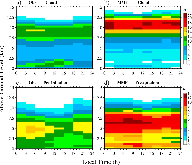The Diurnal Cycle of Clouds and Precipitation at the ARM SGP Site: An Atmospheric State-Based Analysis and Error Decomposition of a Multiscale Modeling Framework Simulation
- Univ. of Washington, Seattle, WA (United States)
Long–term reflectivity data collected by a millimeter cloud radar at the U.S. Department of Energy (DOE) Atmospheric Radiation Measurement (ARM) Southern Great Plains (SGP) site are used to examine the diurnal cycle of clouds and precipitation and are compared with the diurnal cycle simulated by a Multiscale Modeling Framework (MMF) climate model. The study uses a set of atmospheric states that were created specifically for the SGP and for the purpose of investigating under what synoptic conditions models compare well with observations on a statistical basis (rather than using case studies or seasonal or longer time scale averaging). Differences in the annual mean diurnal cycle between observations and the MMF are decomposed into differences due to the relative frequency of states, the daily mean vertical profile of hydrometeor occurrence, and the (normalized) diurnal variation of hydrometeors in each state. Here the hydrometeors are classified as cloud or precipitation based solely on the reflectivity observed by a millimeter radar or generated by a radar simulator. The results show that the MMF does not capture the diurnal variation of low clouds well in any of the states but does a reasonable job capturing the diurnal variations of high clouds and precipitation in some states. In particular, the diurnal variations in states that occur during summer are reasonably captured by the MMF, while the diurnal variations in states that occur during the transition seasons (spring and fall) are not well captured. Overall, the errors in the annual composite are due primarily to errors in the daily mean of hydrometeor occurrence (rather than diurnal variations), but errors in the state frequency (that is, the distribution of weather states in the model) also play a significant role.
- Research Organization:
- Univ. of Washington, Seattle, WA (United States)
- Sponsoring Organization:
- USDOE
- Grant/Contract Number:
- SC0008585; SC0018190
- OSTI ID:
- 1512281
- Journal Information:
- Journal of Geophysical Research: Atmospheres, Vol. 122, Issue 24; ISSN 2169-897X
- Publisher:
- American Geophysical UnionCopyright Statement
- Country of Publication:
- United States
- Language:
- English
Web of Science
Similar Records
Use of ARM observations and numerical models to determine radiative and latent heating profiles of mesoscale convective systems for general circulation models
A Comparison of Simulated Cloud Radar Output from the Multiscale Modeling Framework Global Climate Model with CloudSat Cloud Radar Observations






